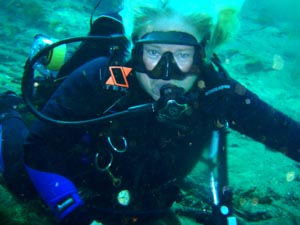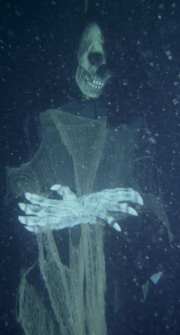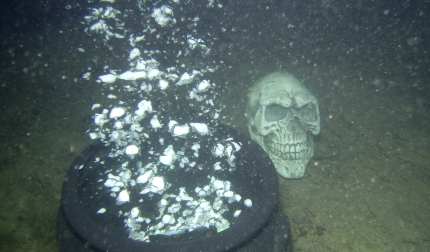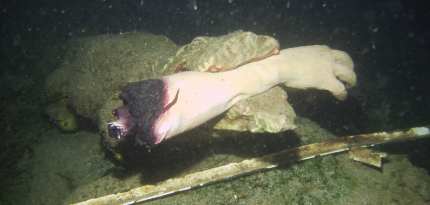« October 2006 | Main | December 2006 »
November 11, 2006
Ego ... Know Your Limits
"C'mon! Don't be a fraidicat! You can do it! Chicken! I'll watch over you ... Trust me!"
This is a prime example of someone trying to pressure someone into doing something they aren't comfortable with. If this happens to you and you don't feel comfortable with the dive location or dive plan ... Just say "NO."
As a new diver, you will find there is an endless array of diving opportunities out there. From rivers to quarries to oceans to wrecks to caves ... And many, many more!
What a lot of new divers may not understand is that a lot of diving environments require additional training and certification. Many of the springs in Florida and Mexico offer diving for beginning divers in overhead environments - caverns. During your beginning scuba course, your instructor should have given you an idea of what is off limits. These overhead environments are off limits until you have successfully completed a cavern diving course. Caverns and caves and old wrecks are often very beautiful and seemingly inviting, but they are have the potential of being dangerous to the unsuspecting new diver.
You may be faced with the decision of whether or not to dive based on the conditions or the environment. Please remember that by diving in an uncomfortable frame of mind, or by being nervous, or apprehensive, mistakes can happen. Situations can turn bad quickly and you don't need to add to the potential hazards.
If you find yourself in a situation such as this, keep in mind you are not only putting yourself at risk, but everyone in the dive team, as well.
As a new diver, it's a good idea to dive with other divers who have more experience than you. A seasoned diver can help you in ways other new divers cannot. You will learn different people's skills and habits. You will find ways to do things that better suit you. Watch them. Learn from them. Appreciate them. Remember their kindness and willingness to help you. Once you have more experience you might want to look for a new diver to take under your wing for a while. In doing that, there is a sense of satisfaction that cannot be duplicated.
Who knows ... By helping others you might find you want to become a Dive Master or even an Instructor. I found out very early on that I would choose the leadership path. I have never regretted that decision.
Posted by Carol at 04:09 PM | Comments (0)
November 06, 2006
How I Conduct a NAUI Advanced Class
All of these are very good questions to ask. Quite often newly certified divers wonder if they are ready to take my Advanced class and my response is ... by all means ... sign up! I always welcome new divers into my Advanced class. Being asked to help a new diver in continuing their education is a joy and an honor for any instructor.
 Brand new divers tend to be eager to learn, and that is good. I enjoy opening new doors for their interests to blossom. I like to think I do so in an encouraging and helpful way. In no way is an Advanced class going to make a person an instant expert in any area. It does, however, give them additional knowledge on which to build upon and enjoy our sport.
Brand new divers tend to be eager to learn, and that is good. I enjoy opening new doors for their interests to blossom. I like to think I do so in an encouraging and helpful way. In no way is an Advanced class going to make a person an instant expert in any area. It does, however, give them additional knowledge on which to build upon and enjoy our sport.
A NAUI Advanced Course includes at least six dives in different areas. Depending on where you are taking the course, the types of dives will vary. When completing an Advanced class in the ocean your training will likely include a non-penetration wreck dive and/or a drift dive.
When I teach an Advanced class locally, I usually begin with a buoyancy clinic. We discuss and correct issues such as proper weighting, proper trim in the water, proper finning techniques, and all around general comfort in the water.
All too often beginning divers are over-weighted for their evaluation dives and don't realize how much more efficient they would be with the proper amount of weight, as opposed to what they may have carried previously. Instructors often over-weight so students can stay comfortably on the bottom or on a training platform to practice their basic skills without floundering around. However, getting in the habit of wearing too much weight will hinder good buoyancy skills, and that in turn makes your air consumption worse.
By wearing the correct amount of weight a new diver will find neutral buoyancy much easier to achieve. When you use less air in your BC to remain neutrally buoyant, you have more air to breathe! By being more comfortable in the water your breathing rate will slow down. Better buoyancy + slower breathing = better air consumption + longer bottom time!
After everyone in the class has a grip on neutral buoyancy and comfort, we move on to using certain tools. We discuss and demonstrate the use of lift bags and safety markers. I explain that you should never attempt to bring up an object that weighs more than your weightbelt without the use of a lift bag. I explain the features of the lift bags and the function of each feature. I show the students a couple of styles of safety markers. We discuss the pros and cons of each. Once we have completed the workshop we put the lift bag to use! Any tools you might want to use underwater require practice underwater.
On the third dive we put all the components of the first dive into use. We plan a dive to find out what each diver's air consumption rate is. I generally plan the dive to 35 feet, spending 20 minutes at depth, then doing a safety stop at 15 feet for three minutes. Each diver is responsible for remembering his/her own air pressure used. The diver makes note of starting tank pressure and the remaining pressure at the end of 20 minutes at depth.
I explain converting pressure to cubic feet of air used, then calculating air consumption based on the dive. Let's use an aluminum 80 cubic foot tank as an example. Aluminum 80s have a working pressure of 3,000 psi. Divide the tanks volume (80) by working pressure (3000) to find the cubic feet per psi. To find out how many cubic feet of gas used during the designated dive time, multiply the number by the psi used. To find out how much air would have been used at the surface we then divide that number by 2, since 35 feet in fresh water is very close to 2 ATAs. Divide this number by 20 minutes and the answer gives you your air consumption in cubic feet.
Example: 80 cu ft tank, 1000 psi used, 35 feet for 20 minutes.
80/3000 = 0.0266666 X 1000 = 26.6666/2 = 13.3333/20 = 0.666665
This diver's surface air consumption rate would be .66 cubic feet per minute.
New divers often learn their surface air consumption rate is anywhere between .66 and 1.1 cubic feet per minute. The more you dive and the more comfortable you become, the less air you will consume. Knowing how much air you consume on the surface will allow you to better plan your dives. Knowing planned depths and tank volumes, you can figure out roughly how much time you can spend diving.
Next we plan and conduct a night dive. The first rule of night diving is to dive the site in the daytime first. Familiarize yourself with the entry, the exit, and any points of interest you care to see and explore. I demonstrate light signals. I remind everyone to keep your light beam out of everyone's eyes. Acclimating to darkness takes 20 minutes or so, however, losing it takes just a split second! I often add a little challenge to the dive by taking students to a local river. This way they get to familiarize themselves with current, too.
The deep dive is next. We spend time reviewing dive tables. Since the students will also be doing a navigation dive later in the day, they plan both dives and a surface interval based on the information I supply about the dives.
Quite often I conduct the Advanced class at Loch Low-Minn quarry in Athens, Tennessee. The deepest section of the quarry is roughly 80 feet and not often vey clear. Often the visibility is good, but the ambient light is lacking, due to the algae bloom in the shallower water. One thing everyone will discover is what a thermocline is! And there are things to see: Recently 70+ paddlefish were released in the quarry, and they prefer the deeper water, so I suspect we'll be meeting them during future deep dives there.
Last, but certainly not least, is the navigation dive. This can be challenging, so I save it for last. Successful navigation begins with proper planning of the dive and clarifying the role of each member of the dive team. We introduce indirect read and direct read compasses to the students. We discuss all the features of compasses and demonstrate how to use them. They perform a few patterns on land, then donn gear for surface skills.
We explain the usefulness and importance of measuring distance underwater. Each student then follows a measured line and counts his/her kick cycles. They do this twice and find an average. Each student is given a direction and a distance and asked to do a reciprocal heading back to their starting point. Once this is done, they are asked to swim a square search pattern using kick cycles and the compass in returning to where they began.
And then the fun begins! Each team prepares for their navigation dive, discussing each person's responsibilities. My navigation course is rather unique in that there are no signs of the course from the surface!
A rescue is a required dive for the Advanced certification. Since I include a detailed rescue in my beginning class, I do not dwell on it, but we do discuss proper techniques and practice being victim and the rescuer.
The exact sequence for a successful rescue includes locating the victim, shaking them to see if they respond, and assume control by placing your knees on either side of the victims scuba tank. As you remain above the victim, steadying yourself on their back, be sure to maintain an open airway by cradling his/her chin in your right hand and aiming their face towards the surface. Attempt to bring the victim up by inflating his/her BC. If the victim's scuba tank is empty, you must use your own BC to begin the ascent. Remember the rate of ascent is crucial - no faster than your smallest exhaled bubbles! Once on the surface, call for help, then check the victim's airway, breathing and circulation. Get the victim out of the water and out of his/her gear, lay him/her flat on his/her back with feet elevated. Call Diver's Alert Network (DAN) at 1-919-684-8111. Do what you can to make the victim comfortable, maintain life support and wait for further instruction and assistance.
And that, my friend, is my Advanced Class! Care to join us?
Posted by Carol at 04:08 PM | Comments (0)
November 01, 2006
Haunted Night Dive, Anyone?
Each October for the past few years, there's been a murmur at Loch Low-Minn quarry of a Haunted Night Dive. Just to set the record straight, it's not a rumor ... It's a fact! Ok, so there may not be any REAL ghosts, but there are some that "hang" around underwater!
The idea for a Haunted Night Dive hit me while walking through a Halloween store. Ted and I decided we'd make it a project and have all of my Dive Master candidates participate.
We started gathering monsters and goblins and ghouls ... pumpkins and ghosts and cauldrons ... witches and bats and spiders ... things that go Bump in the night.
 Once everything was on paper, the real planning and preparation began. We figured out what all props we had and drew out a map of the area we were to decorate. Once a route was in place, we began the prep work of the props.
Once everything was on paper, the real planning and preparation began. We figured out what all props we had and drew out a map of the area we were to decorate. Once a route was in place, we began the prep work of the props.
How would we suspend the ghosts? The pumpkins? The bats? How would we illuminate them all? Well, we used a lot of balloons and chemical glow sticks! How would we make the cauldron bubble? Easy! A scuba tank would be attached to a device that would slow the flow of air down.
Over the course of the weekend we learned a few things. First, an inflated balloon is next to impossible to sink! We'd later design another method that would better suit our needs. Second, we learned the chemical glow sticks are an excellent way to illuminate the path! Third, we learned that even by slowing down the flow of air drastically, the air didn't last long enough, so it was back to the drawing board.
This year we perfected some of our techniques and found solutions for other problems. The ghosts were a piece of cake. Each ghost is made up of a white plastic bathroom garbage can turned upside down. Three holes are drilled in the lip of the can to allow for three strings to hold it in place. A small anchor made of concrete was made and strategically placed in the quarry. The strings were attached to these anchors and air was purged into the cans. A white sheet was then draped over the can and two blue chemical glow sticks were placed inside.
The pumpkins were those plastic pails that kids use for Trick or Treating. A hole is drilled in the bottom and a neoprene ring is glued to the underside of the pumpkin to give it more flotation. Without the neoprene, the pumpkin is only slightly positively buoyant. Two glow sticks are attached to a string that runs through the hole in the bottom. The string is then tied to a rock and stays somewhat stationary unless disturbed.
The bubbling cauldron problem was solved with a little thought. Ted found that a few pounds of dry ice, a three pound weight, and three green glow sticks were the answer! The dry ice bubbled for over an hour in water 67 degrees ... Plenty of time for all the divers to see and enjoy the effect.

My dear friend Donna and her husband Tom donated a coffin last year, so we used it again for a corpse made of a mannequin draped with black fabric, a skeleton mask, skeleton glove hands, and an axe. A glow in the dark tombstone at its head read "R.I.P"
Bats were hanging in trees, tarantulas were also. A witch had "melted" on the quarry floor, leaving behind only a black cape, a broom, and her hat. A pirate was hiding in a rock pile, a ghoul was suspended above the platform, glowing pairs of eyes were lurking amongst the grasses, severed body parts were scattered along the quarry floor, hanging out of a concrete alligator's mouth, and out of the Loch Ness Monster's mouth as well.

Hot chocolate and flavored coffee awaited all divers once they exited the water. The air temperature was much colder than the 67 degree water, but everyone agrees it's always worth the effort to make this dive.
Next year's Haunted Night Dive will be a bit different. I will not be responsible for pulling the entire thing off. Stacy and Rick and I have decided to get more divers involved by making it more of a contest among individual divers and groups. Everyone will construct their own creative display and place it in the quarry early in the month of October. Everyone will have the opportunity to vote for their favorite display. A night dive will be planned so that everyone can enjoy the area in an eerier light. Later in the month the votes will be tallied and a winner will be announced.
If you'd like more information or suggestions in creating your own Haunted Night Dive, or if you have ideas you'd like to offer, please contact us. We're always open to suggestions!
Posted by Carol at 04:07 PM | Comments (0)